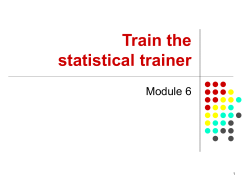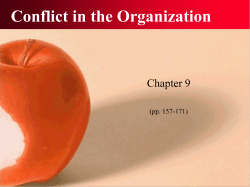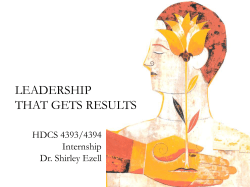
A Comparison of Learning Styles among Successful & Unsuccessful
Applied mathematics in Engineering, Management and Technology 2 (3) 2014:528-533 www.amiemt-journal.com A Comparison of Learning Styles among Successful & Unsuccessful Students of Mazandaran University of Payame Noor (A Northern Province of Iran)* Masoomeh HezarJaribi1, Akbar Naghipour2 1 Department of Mathematics, Payame Noor University, p.o.box.19395-3697, Tehran, Iran E-mail address: masoomeh.hezarjaribi@pnu.ac.ir 2 M.S. In clinical psychology, Counselor at Education Organization, Tonekabon, Iran Abstract This study aimed to compare the learning styles of students based on some of academic and demographic variables of them. Population consisted of all students studying mathematics in Payame Noor Univesrsity (PNU) of Mazandaran province in 2013. Using stratified random sampling according to Morgan table, 120 students were selected as sample. Kolb's Learning Style Inventory was used to measure. To analyze the data, chi-square test was used. Descriptive analysis of the data suggests that successful and unsuccessful students, respectively, have Assimilating and divergent learning style. Also, The first and second year students have a Convergent style and Third and fourth year students had Assimilator style. But overall, regardless of academic performance, a balanced distribution between the four learning styles has been observed. The analytical results showed that the students' learning style according to academic performance and gender is different, but these differences were not significant according to the grades of students Keywords: learning styles, academic performance, students of mathematics, Payame Noor University 1.Introduction Impact of personal differences in learning has come into the focus of scholars and theorists in education-based areas of study. The beginning attempts for understanding human's learning process have been made in 427 BC when Socrates and Plato investigated the origin of knowledge. But, formal hypotheses about differences in learning owe its origin to Herbert Thelen who introduced the term "learning style" in 1954. This assumption that differences in learning arises from differences in mental ability had long been accepted in education-based areas of study, but then a number of scholars challenged it. Indeed, scholars found that people had different learning styles i.e. they organize and manipulate information in their own ways. (Emamipour and Shams Esfandabad, 2007) We think of learning style as the way of learning which the learner prefers over other ways. Some educational psychologists call learning style as "learning preference" and some others define them as "learning strategy" and "cognitive style"(Karimi, 2012). In one classification, learning styles are divided into three categories including cognitive style, emotional style, and physiological style (Hosseini Largani and Seif, 2001). Learning styles are defined as the ways on the basis of which persons gain understanding of matters, retain information, give them careful thought, and resolve the problems. Emotional styles of learning involve learner's personality and his emotional reactions such as perseverance, working alone or with others, and acceptance or refusal of external reinforced factors. Physiological styles of learning are biological-based and are caused by reactions to physical environment features which have influence in learning such as time of study (i.e. night or day), and study in cool or warm places. Among these three learning styles, scholars have often carried out studies on cognitive learning style and they have attached the greatest significance to them (Ahmadi, 2011). Cognitive learning style comprises different categories such as field-dependence (holistic) style, field-independence style, reflective and impulsive style, and learning style based on Kolb's experimental learning model (Kalbasi et al, 2007). The most common category of learning styles is Kolb's model-based one. Kolb divides learning process into 4 steps: 1.1.Concrete Experimentation: 528 Applied mathematics in Engineering, Management and Technology 2 (3) 2014 M. HezarJaribi and A. Naghipour It relates to learning through particular sensations and experiences. In this step, learner relies more on his personal sensation, and abilities than on structured approaches to problems and situations. 1.2.Reflective observation: This step relies on close observation and consideration from different perspectives. Here, the learner gains understanding of situations from different perspectives and observes them carefully. This step is based on hearing and seeing. 1.3.Abstract conceptualization: Here, the learning often results from thinking. In other words, the learner relies more on his thought and reasoning than his sensation. 1.4.Active experimentation: learner makes this learning step due to performance and experience of changes in situations. (Hosseini Largani and Seif, 2001) Combining the above four steps, Kolb determines four learning styles ( figure 1) which are as follows: Convergent style, divergent style, assimilation style, and accommodation style. (Meyari et al, 2009) Figure 1: Kolb Learning Styles Persons with divergent learning (A combination of concrete experimentation and reflective observation) demonstrate the most ability in observing concrete situations from different perspectives and their approaches rely more on observation rather than on action. As regards convergent learning, there is a combination of abstract conceptualization and active experimentation. Persons with this learning style are highly capable of thought provoking and working on theories. They prefer to deal with technical issues rather than with social and interpersonal issues. Assimilation style is a combination of abstract conceptualization and reflective observation, on the basis of which we gain rational and adequate understanding about large pieces of information. Persons with accommodation style adopt combined style of concrete experimentation and active experimentation. They are highly capable of learning due to first-hand experiences. In addition, for capturing information regarding problem-solving, they rely more on others than on their own analysis and reasoning (Emamipour and Shams Esfandabad, 2007). Many scholars have conducted their studies on learning styles, in accordance with Kolb's model. We present a review for them in this section. Kalbasi et al (2007) examines the dominant learning styles among students of Tehran University of Medical Sciences, Tehran University of Human Sciences, and Tehran University of Engineering and Technology 529 Applied mathematics in Engineering, Management and Technology 2 (3) 2014 M. HezarJaribi and A. Naghipour respectively as follows: divergent learning, accommodation style, and divergent learning. Hosseini Largani and Seif (2001), similarly, study of predominant learning styles among students in other branches of the abovementioned universities. His findings reveal that students in University of Human Sciences are often accommodation-style-based, students in University of Medical Sciences are assimilation-style-based, and students in University of Engineering and Technology are divergent-style-based. Also, there is no significant relationship between age, gender, and learning style. Rahmani (2000) points out students in University of Human Sciences, University of Medical Sciences, University of Engineering and Technology, and University of Art often adopt accommodation style, assimilation style, divergent learning, and convergent learning respectively. Also, in his study on other branches of these universities, Yar Mohammadi Vasel (2000) found that accommodation style, convergent learning, assimilation style, and divergent learning are predominant respectively in them. Findings of Heffler (2001) indicated that males and females are different in abstract conceptualization and concrete experimentation. Females gain higher scores in concrete experimentation while males gain higher scores in abstract conceptualization. Deciantis and Kirton (1996)emphasized that female students rely more on sensation than thinking. In other words, they gain higher scores in concrete experimentation in Kolb's Learning Style Inventory while male students have higher scores in abstract conceptualization (Ahmadi, 2011). Severiens and Ten Dam (1994)perform a meta-analysis on 19 studies and find that males gain higher scores in abstract conceptualization as compared with females (ibid.) Findings of Homayoni et al. (2006) show students with cognitive and field-independence learning style often choose to receive education in mathematics and experimental studies while students with cognitive and fielddependence learning style often prefer to receive education in human sciences. Furthermore, students with convergent and assimilation learning often choose to receive education in mathematics and experimental studies as compared with students with divergent and accommodation learning. But, students with divergent learning are more oriented towards human sciences, unlike students with convergent and assimilation learning style. Further studies on learning styles especially in students can enrich understanding for educational authorities and educators. As the result, the present study attempts to examine students' learning styles in terms of gender (males and females), educational achievement (successful and unsuccessful outcomes), and year of university (first, second, third and fourth years of university). 2.Methodology The present study was a causal-comparative descriptive research. The population consisted of all mathematics students (250 students) of Mazandaran University of Payame Noor (a northern province of Iran). Among this population, we selected 120 students by using Morgan and Kerjesi Table and random sampling. We collected our data by using Kolb's Learning Style Inventory. This inventory has been designed to develop an understanding of learner's learning process rather than to evaluate his ability, in which there is no true and false response and all response options are equally acceptable. It contains 12 question items, being distributed in 4 sections including concrete experimentation, reflective observation, abstract conceptualization, and active experimentation. Each sentence of this inventory has 4 response options and the learner sorts them from score 1 to score 4 on the basis of his learning style. This research confirmed its validity by using factor analysis (Emamipour and Shams Esfandabad, 2007). As far as learning styles of Iranian students were concerned, Hosseini Largani and Seif (2001) measured its reliability as shown in Table 1. Learning styles Cronbach's alpha Table 1: reliability of Kolb questionnaire based on Cronbach's alpha Abstract Concrete Active conceptualization experimentation experimentation 0.77 0.70 0.76 Reflective observation 0.70 In addition, we used frequency index Chi-square respectively for descriptive analysis of data and for analytical evaluation. 3.Results and Discussion 530 Applied mathematics in Engineering, Management and Technology 2 (3) 2014 M. HezarJaribi and A. Naghipour After collecting questionnaires, we performed descriptive analysis on data. We calculated the frequency of learning styles among students in terms of their educational achievement. Table 2 shows the results. Table 2: Frequency of learning styles according to gender and academic performance of students Students Divergent Convergent Assimilation Accommodation Male 8 21 19 8 Successful Female 6 5 10 3 Male 14 2 4 8 Unsuccessful Female 5 3 3 1 Total 33 31 36 20 As Table 2 shows, about 36% of successful students adopted assimilation learning and about 47% of unsuccessful students adopted divergent learning. However, in general, all four learning styles showed equal distribution, regardless of educational achievement. Then, we calculated the frequency of learning styles in terms of both educational achievement and gender. The results are shown in Table 3. Table 3: frequency of students' learning style according to performance and academic year Students Divergent Convergent Assimilation Accommodation Successful 4 10 10 4 first and second year Unsuccessful 7 4 1 3 Successful 10 12 19 7 Third and fourth year Unsuccessful 12 3 6 6 Total 33 31 36 20 As seen in Table 3, about %33 of first year and second year students often adopted convergent learning. Similarly, about 33 percent of Third and fourth year students preferred assimilation learning style. Due to great frequency of the above-mentioned data, we followed non-parametric Chi-square in order to determine any significant difference and to examine our hypotheses. Table 4 shows a summary of this method process. Table 4: Inferential analysis results of the research hypotheses Observed chiChi-square hypotheses square values in Table Comparison of student learning styles based on their 17/46 7/8 academic performance Comparison of student learning styles based on their 19/24 7/8 academic performance and gender Comparison of student learning styles based on their 10/05 16/91 academic performance and year Significance Significant Significant Not significant Chi-square results demonstrated significant difference in predominant learning styles among successful students and unsuccessful students. Considering gender variable along with educational achievement variable, we again observed significant difference. Conversely, there was no significant difference in learning styles, as regards years of university and educational achievement. 4.Conclusion This study focused on analysis of the status of learning styles of students of PNU of Mazandran studying in mathematics Based on demographic and academic variables. Some parts of results showed that although there is deference between students' learning styles based on their academic performance and gender and Assimilator learning style, But with the added variable of academic performance, students who have failed, are more oriented towards the divergent learning. These findings are consistent with the findings of Demirbas and 531 Applied mathematics in Engineering, Management and Technology 2 (3) 2014 M. HezarJaribi and A. Naghipour Demirkan (2003), Hosseini Largani and Seif (2001), Rahmani (2000), Yar Mohammadi Vasel (2000), and Homayoni et al (2006), but not with the findings of Karimi (2012). Also, in this study we concluded that academic year will not cause significant difference in students' learning styles. This finding is not consistent with the findings of Karimi (2012) and Meyari et al (2009) . They tried to explain students' learning style based on academic year variable, but basically, learning style is a trait that from the beginning of learning, develop in person and it does not seem that increasement of the grades within a short period can create major changes In individual learning styles.in this regard, Karimi (2012) quoted from Demirbas and Demirkan (2003) that the greatest progress was related to in assimilating learners and accommodating learners had less progress in a semester. He in his study showed that Students with divergent learning styles had the best performance and convergent students had the weakest performance in architectural design studio. Meyari et al (2009) in a study showed that learning style of students in the first year was convergent and assimilation and for fifth-year students were convergent and accommodation. Emamipour and Shams Esfandabad (2007) Quoted from philbin, that almost half of men were assimiliator while only 20 percent of women were of this style but Hosseini Largani and Seif (2001) reported that there is no difference between men's and women's learning style. Overall, the findings of this study with other research findings, suggesting different results , so it seems to still need more research to be done in this regard, Especially considering the fact that an important part of academic performance depends on learning style and different learning styles make different educational outcomes, So both learners and education system brokers, especially teachers and professors Should be more sensitive to this To enable us to identify and provide the necessary revisions. 5.Acknowledgment This study is an extraction from a research project titled "A Comparison of Learning Styles among Successful & Unsuccessful Students in Mazandaran University of Payame Noor" which was supported by Mazandaran University of Payame Noor. References Ahmadi, S. and Ahmadi, M. (2011). The relationship between math anxiety and learning styles of students. Research on Curriculum, 8(102): 31-89. Deciantis,M.S,Kirton,M.J. (1996)psychometric Reexamination of Kolb’s Experiential learning Cycle construct: A separation of Level , style and review Process,educational and psycholodical Measurment,56(5),809-820. Demirbas, D.D. & Demirkan, H. (2003). Focus on architectural design process through learning styles. Design Studies Journal, (24): 437- 456. Emamipour, S and Shams Esfandabad, H. (2007). Learning styles and cognitions. first edition, Tehran: Samt. Heffler,B.(2001)Indidvidual learning style and learning style inventory , educational studies,27(3),307-316. Homayoni, A et al (2006). The relationship between learning and cognitive styles and academic course selection in high school male students. Iranian Journal of Psychology, 3(10):137-144. Hosseini Largani, M. and Seif, AA. (2001). Comparison of students' learning styles according to gender and levels and field of study. Journal of Research and Planning in Higher Education, 19:93-114. Kalbasi, S et al (2008). Birjand University of Medical Sciences students’ learning styles. Journal of Medical Education and Development Center, 5(1) :10-16. Karimi, M. (2012). The relationship between learning styles and students performance in architecture workshop. Bagh-e Nazar Quarterly, 9(20):3-12. Meyari, A et al (2009). Comparing the first and fifth year students' learning styles and its relationship with academic achievement. Journal of Strides in Development of Medical Education, 6(2):110-118. Rahmani, Sh. (2000). The relationship between cognitive styles in four different fields of humanities, medicine, engineering and art based on Aizeng personality traits. M.S. thesis, Faculty of Psychology and Educational Sciences, Allameh Tabatabai University, Tehran,Iran Severiens, S.E., and Ten Dam, G. T. M.(1994).Gender differences in learning styles: A narrative review and quantitative meta-analysis, Higher Education,27,487-510. 532 Applied mathematics in Engineering, Management and Technology 2 (3) 2014 M. HezarJaribi and A. Naghipour Yar Mohammadi Vasel, M. (2000). Comparison of cognitive styles (converging, diverging, assimilating and accommodating) of male and female students and professors in human sciences, medicine, engineering and art. M.S. thesis. Faculty of Psychology and Educational Sciences, Allameh Tabatabai University, Tehran,Iran. 533
© Copyright 2025









